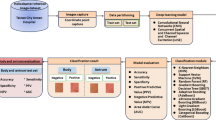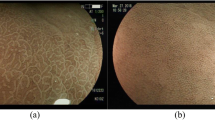Abstract
This work aimed to improve the early clinical diagnosis rate of atrophic gastritis (AG) and reduce the risk of disease deterioration or cancerization. Three hundred and eight patients with gastric disease were taken as the research object, who were divided into two groups: AG (n = 159) and non-AG (n = 149), according to the diagnosis results. The gastric antrum images of patients were collected, and the DenseNet model for gastric antrum image lesion screening was improved. Then, the differences in serum pepsinogen (PG I and PG II) of patients were detected, and the efficiency of different methods to screen AG was compared. The results revealed that the levels of PG I and PG II in AG patients were substantially reduced, and the sensitivity (70.44%), specificity (66.44%), and accuracy (68.51%) of AG diagnosis by indicator PG I were higher than that of PG II and joint diagnosis. The diagnosis accuracy rate of AG based on the improved DenseNet model was 98.63%. The accuracy of model recognition combined with serological indicators for disease diagnosis was as high as 99.25%, with a sensitivity of 96.17% and a specificity of 94.33%. In summary, the combination of deep learning-based image recognition methods and serological specific indicators could improve the clinical diagnosis rate of AG, which could provide a reference for the subsequent clinical adoption of artificial intelligence recognition technology.












Similar content being viewed by others
References
Yao F, Shi CL, Liu CC et al (2017) Economic burden of stomach cancer in China during 1996–2015: a systematic review. Zhonghua Yu Fang Yi Xue Za Zhi 51(8):756–762
Venneman K, Huybrechts I, Gunter MJ et al (2018) The epidemiology of Helicobacter pylori infection in Europe and the impact of lifestyle on its natural evolution toward stomach cancer after infection: a systematic review. Helicobacter 23(3):e12483
Li Y, Xia R, Zhang B, Li C (2018) Chronic atrophic gastritis: a review. J Environ Pathol Toxicol Oncol 37(3):241–259
Rodriguez-Castro KI, Franceschi M, Miraglia C et al (2018) Autoimmune diseases in autoimmune atrophic gastritis. Acta Biomed 89(8):100–103
Tahara S, Tahara T, Horiguchi N et al (2019) DNA methylation accumulation in gastric mucosa adjacent to cancer after Helicobacter pylori eradication. Int J Cancer 144(1):80–88
Xuan Y, Hur H, Byun CS et al (2013) Efficacy of intraoperative gastroscopy for tumor localization in totally laparoscopic distal gastrectomy for cancer in the middle third of the stomach. Surg Endosc 27(11):4364–4370
Thillaikkarasi R, Saravanan S (2019) An enhancement of deep learning algorithm for brain tumor segmentation using kernel based CNN with M-SVM. J Med Syst 43(4):84
Hussain S, Anwar SM, Majid M (2017) Brain tumor segmentation using cascaded deep convolutional neural network. Annu Int Conf IEEE Eng Med Biol Soc 2017:1998–2001
Yamaguchi Y, Nagata Y, Hiratsuka R et al (2016) Gastric cancer screening by combined assay for serum anti-Helicobacter pylori IgG antibody and serum pepsinogen levels-the ABC method. Digestion 93(1):13–18
Leja M, Park JY, Murillo R et al (2017) Multicentric randomised study of Helicobacter pylori eradication and pepsinogen testing for prevention of gastric cancer mortality: the GISTAR study. BMJ Open 7(8):e016999
Begum A, Baten MA, Begum Z et al (2017) Role of serum pepsinogen I and II ratio in screening of gastric carcinoma. Mymensingh Med J 26(3):628–634
Yoon K, Kim N (2018) Reversibility of atrophic gastritis and intestinal metaplasia by eradication of Helicobacter pylori. Korean J Gastroenterol 72(3):104–115
Jin EH, Chung SJ, Lim JH (2018) Training effect on the inter-observer agreement in endoscopic diagnosis and grading of atrophic gastritis according to level of endoscopic experience. J Korean Med Sci 33(15):e117
Chapelle N, Petryszyn P, Blin J, Leroy M, Tamara Matysiak〣udnik (2020) A panel of stomach: specific biomarkers (gastropanel) for the diagnosis of atrophic gastritis: a prospective, multicenter study in a low gastric cancer incidence area. Helicobacter 25(5):2020
Zagari RM, Rabitti S, Greenwood DC et al (2017) Systematic review with meta-analysis: diagnostic performance of the combination of pepsinogen, gastrin-17 and anti-Helicobacter pylori antibodies serum assays for the diagnosis of atrophic gastritis. Aliment Pharmacol Ther 46(7):657–667
Tong Y, Wu Y, Song Z et al (2017) The potential value of serum pepsinogen for the diagnosis of atrophic gastritis among the health check-up populations in China: a diagnostic clinical research. BMC Gastroenterol 17(1):88
Cavalcoli F, Zilli A, Conte D, Massironi S (2017) Micronutrient deficiencies in patients with chronic atrophic autoimmune gastritis: A review. World J Gastroenterol 23(4):563–572
PérezRomero S, Alberca de Las Parras F, SánchezDelRío A et al (2019) Quality indicators in gastroscopy. Gastroscopy procedure. Rev Esp Enferm Dig 111(9):699–709
Nishihara K, Oono Y, Kuwata T et al (2019) Depressed gastric-type adenoma in nonatrophic gastric mucosa without Helicobacter pylori infection. Endoscopy 51(6):E138–E140
Grewal PS, Oloumi F, Rubin U, Tennant MTS (2018) Deep learning in ophthalmology: a review. Can J Ophthalmol 53(4):309–313
Litjens G, Ciompi F, Wolterink JM et al (2019) State-of-the-art deep learning in cardiovascular image analysis. JACC Cardiovasc Imaging 12(8 Pt 1):1549–1565
Kumar M, Alshehri M, Alghamdi R, Sharma P, Deep V (2020) A de-ann inspired skin cancer detection approach using fuzzy c-means clustering. Mobile Netw Appl 25:1319–1329
Wang S, Yang DM, Rong R, Zhan X, Xiao G (2019) Pathology image analysis using segmentation deep learning algorithms. Am J Pathol 189(9):1686–1698
Sahiner B, Pezeshk A, Hadjiiski LM et al (2019) Deep learning in medical imaging and radiation therapy. Med Phys 46(1):e1–e36
Xiao Y, Wu J, Lin Z, Zhao X (2018) A deep learning-based multi-model ensemble method for cancer prediction. Comput Methods Programs Biomed 153:1–9
Al-Khafaji SL, Jun Z, Zia A, Liew AW (2018) Spectral-spatial scale invariant feature transform for hyperspectral images. IEEE Trans Image Process 27(2):837–850
Zhou Q, Zhou Z, Chen C et al (2019) Grading of hepatocellular carcinoma using 3D SE-DenseNet in dynamic enhanced MR images. Comput Biol Med 107:47–57
Su W, Zhou B, Qin G et al (2018) Low PG I/II ratio as a marker of atrophic gastritis: association with nutritional and metabolic status in healthy people. Medicine (Baltimore) 97(20):e10820
Mansour-Ghanaei F, Joukar F, Baghaee M, Sepehrimanesh M, Hojati A (2019) Only serum pepsinogen I and pepsinogen I/II ratio are specific and sensitive biomarkers for screening of gastric cancer. Biomol Concepts 10(1):82–90
Mezmale L, Isajevs S, Bogdanova I et al (2019) Prevalence of atrophic gastritis in Kazakhstan and the accuracy of pepsinogen tests to detect gastric mucosal atrophy. Asian Pac J Cancer Prev 20(12):3825–3829
Massarrat S, Haj-Sheykholeslami A (2016) Increased serum pepsinogen II level as a marker of pangastritis and corpus-predominant gastritis in gastric cancer prevention. Arch Iran Med 19(2):137–140
Zagari RM, Rabitti S, Greenwood DC, Eusebi LH, Vestito A, Bazzoli F (2017) Systematic review with meta-analysis: diagnostic performance of the combination of pepsinogen, gastrin-17 and anti-Helicobacter pylori antibodies serum assays for the diagnosis of atrophic gastritis. Aliment Pharmacol Ther 46(7):657–667
Shao X, Zhang H, Wang Y et al (2020) Deep convolutional neural networks combine Raman spectral signature of serum for prostate cancer bone metastases screening. Nanomedicine 29:102245
Guan Q, Wang Y, Ping B et al (2019) Deep convolutional neural network VGG-16 model for differential diagnosing of papillary thyroid carcinomas in cytological images: a pilot study. J Cancer 10(20):4876–4882
Dawud AM, Yurtkan K, Oztoprak H (2019) Application of deep learning in neuroradiology: brain haemorrhage classification using transfer learning. Comput Intell Neurosci 2019:4629859
Ding Y, Sohn JH, Kawczynski MG et al (2019) A deep learning model to predict a diagnosis of Alzheimer disease by using 18F-FDG PET of the brain. Radiology 290(2):456–464
Brito C, Machado A, Sousa A (2019) Electrocardiogram beat-classification based on a ResNet network. Stud Health Technol Inform 264:55–59
Cai J, Xing F, Batra A et al (2019) Texture analysis for muscular dystrophy classification in MRI with improved class activation mapping. Pattern Recognit 86:368–375
Author information
Authors and Affiliations
Corresponding author
Additional information
Publisher's Note
Springer Nature remains neutral with regard to jurisdictional claims in published maps and institutional affiliations.
Rights and permissions
About this article
Cite this article
Zhang, J., Yu, J., Fu, S. et al. Adoption value of deep learning and serological indicators in the screening of atrophic gastritis based on artificial intelligence. J Supercomput 77, 8674–8693 (2021). https://doi.org/10.1007/s11227-021-03630-w
Accepted:
Published:
Issue Date:
DOI: https://doi.org/10.1007/s11227-021-03630-w




